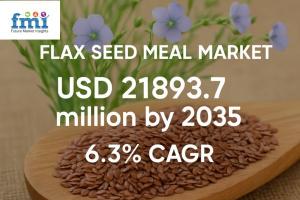Flax Seed Meal Market to Reach USD 21.89 Billion by 2035, Driven by Rising Demand for Organic and Functional Nutrition
The Flax Seed Meal market is experiencing growth due to rising consumer awareness of health and wellness benefits.
As consumers increasingly prioritize nutritional transparency and clean-label ingredients, flax seed meal has emerged as a superfood due to its high content of omega-3 fatty acids, fiber, and lignans. Manufacturers are now focusing on advanced processing technologies such as cold milling and micronization to preserve nutritional value while enhancing bioavailability and product versatility. These innovations support the growing use of flax seed meal in functional foods, beverages, dietary supplements, and pet nutrition, signaling a bright outlook for the market.
Stay Ahead with Market Trends: Access Your Sample Report Now!:https://www.futuremarketinsights.com/reports/sample/rep-gb-2802
Key Industry Highlights:
• Market Value in 2025: USD 11,884.7 million
• Projected Market Value by 2035: USD 21,893.7 million
• Growth Rate: 6.3% CAGR (2025–2035)
• Top Markets by Share (2025):
o Canada: 33.2%
o USA: 21.2%
o China: 11.7%
o Germany: 5.4%
o India: 3.7%
• Key Trends: Rise of cold-milled and micronized flax meal; demand for clean-label, high-fiber products; increasing application in functional and fortified foods.
Collaboration between Small Market Players to Strengthen Product Portfolio:
Smaller companies are actively leveraging strategic partnerships and co-development efforts to diversify their offerings and penetrate niche segments such as gluten-free, keto, and sports nutrition markets. By pooling R&D resources, these players are introducing hybrid flax-based blends and incorporating flax seed meal into ready-to-eat meals, protein bars, and baking mixes. Such collaborations not only bolster their individual brand portfolios but also enhance market competitiveness by bringing affordable, value-added formulations to consumers at scale.
Increased Market Demand: Get In-Depth Analysis and Insights with Our Complete Report:https://www.futuremarketinsights.com/reports/flax-seed-meal-market
Market Concentration:
While the flax seed meal market presents robust opportunities, it remains moderately concentrated, with a handful of major players accounting for a significant portion of global production. Canada, as the world's largest flax producer, contributes over one-third (33.2%) of global market share, closely followed by the USA (21.2%). These regions host vertically integrated supply chains, which offer economies of scale, stringent quality assurance, and faster time-to-market for premium flax products. Nevertheless, emerging markets in Asia-Pacific are witnessing a steady influx of smaller players eager to capture localized consumer bases through cost-effective, high-nutrition solutions.
Country-wise Insights:
• Canada leads global production and export of flax seed meal, driven by its favorable climate, sustainable agriculture practices, and robust government support for agribusiness innovations.
• The USA continues to be a top consumer market, where rising awareness about plant-based nutrition and high-fiber diets is fueling flax seed meal integration into mainstream food categories.
• China and India represent high-growth territories due to rising middle-class populations, growing interest in natural health products, and increased investments in food processing infrastructure.
• Germany exemplifies Europe's strong demand for clean-label, sustainable ingredients, driving adoption in organic food retail and vegan product lines.
Competition Outlook:
The flax seed meal market is witnessing intensified competition, with companies vying to develop functional, convenient, and fortified formulations. Leading players are investing in bio-processing technologies, expanding online and retail distribution networks, and launching region-specific SKUs tailored to local taste and dietary trends. Key strategies include:
Key Industry Players
• Archer Daniels Midland Company
• Cargill Incorporated
• AgMotion Inc.
• Linwoods Health Foods
• Bioriginal Food & Science Corp.
• CanMar Foods Ltd.
• Waltanna Farms
• TA Foods Ltd.
• Shape Foods Inc.
• Prairie Flax Products Inc.
Unlock Key Insights into convenience Food Industry Analysis: https://www.futuremarketinsights.com/industry-analysis/convinience-food
Key Segments of the Report
By Type:
The flax seed meal industry is segmented into golden flax seed and brown flax seed, with increasing demand for nutrient-dense varieties in food, beverages, and supplements.
By Application:
The industry is divided into food and beverages, food additives, bakery & confectionery, egg replacement foods, and pet food, with bakery applications gaining strong traction in global markets.
By Region:
The industry is categorized into North America, Latin America, Western Europe, Eastern Europe, South Asia & Pacific, East Asia, Central Asia, Balkan and Baltic Countries, Russia and Belarus, and The Middle East & Africa.
Explore FMI’s related ongoing Coverage in Food and Beverage Domain:
Flax Protein Market: https://www.futuremarketinsights.com/reports/flax-protein-market
Flaxseeds Market: https://www.futuremarketinsights.com/reports/flaxseeds-market
Flax-based Protein Market: https://www.futuremarketinsights.com/reports/flaxbased-protein-market
About Future Market Insights (FMI)
Future Market Insights, Inc. (ESOMAR certified, recipient of the Stevie Award, and a member of the Greater New York Chamber of Commerce) offers profound insights into the driving factors that are boosting demand in the market. FMI stands as the leading global provider of market intelligence, advisory services, consulting, and events for the Packaging, Food and Beverage, Consumer Technology, Healthcare, Industrial, and Chemicals markets. With a vast team of over 400 analysts worldwide, FMI provides global, regional, and local expertise on diverse domains and industry trends across more than 110 countries.
Contact Us:
Future Market Insights Inc.
Christiana Corporate, 200 Continental Drive,
Suite 401, Newark, Delaware – 19713, USA
T: +1-347-918-3531
Website: https://www.futuremarketinsights.com
Ankush Nikam
Future Market Insights, Inc.
+91 90966 84197
email us here
Visit us on social media:
LinkedIn
Facebook
YouTube
X
Legal Disclaimer:
EIN Presswire provides this news content "as is" without warranty of any kind. We do not accept any responsibility or liability for the accuracy, content, images, videos, licenses, completeness, legality, or reliability of the information contained in this article. If you have any complaints or copyright issues related to this article, kindly contact the author above.
PsychPlus Partners with Dietitian Live to Expand Access to Whole-Person Mental Health Care
Remote Patient Monitoring Devices Market Size to Reach US$ 52.7 Billion by 2035 - Transparency Market Research, Inc.
Aurelian Emerges With a Sound That Cuts Deep and Shines Bright
Więcej ważnych informacji
 Jedynka Newserii
Jedynka Newserii

 Jedynka Newserii
Jedynka Newserii

Farmacja

Nowy pakiet farmaceutyczny ma wyrównać szanse pacjentów w całej Unii. W Polsce na niektóre leki czeka się ponad dwa lata dłużej niż w Niemczech
Jeszcze pod przewodnictwem Polski Rada UE uzgodniła stanowisko w sprawie pakietu farmaceutycznego – największej reformy prawa lekowego od 20 lat. Ma on skrócić różnice w dostępie do terapii między krajami członkowskimi, które dziś sięgają nawet dwóch–trzech lat. W Unii Europejskiej wciąż brakuje terapii na ponad 6 tys. chorób rzadkich, a niedobory obejmują również leki ratujące życie. Nowe przepisy mają zapewnić szybszy dostęp do leków, wzmocnić konkurencyjność branży oraz zabezpieczyć dostawy.
Handel
Wzrost wydobycia ropy naftowej nie wpłynie na spadek cen surowca. Kierowcy jesienią zapłacą więcej za olej napędowy

Sierpień jest trzecim z rzędu miesiącem, gdy osiem krajów OPEC+ zwiększa podaż ropy naftowej na globalnym rynku; we wrześniu nastąpi kolejna zwyżka. Kraje OPEC, zwłaszcza Arabia Saudyjska, chcą w ten sposób odzyskać udziały w rynku utracone na skutek zmniejszenia wydobycia od 2022 roku, głównie na rzecz amerykańskich producentów. Nie należy się jednak spodziewać spadku cen ropy, gdyż popyt powinien być wysoki, a pod znakiem zapytania stoi dostępność ropy z Rosji. Nie zmienia to faktu, że jesienią ceny paliw na stacjach zazwyczaj rosną, a w największym stopniu podwyżki dotyczyć będą diesla.
Nauka
Szacowanie rzeczywistej liczby użytkowników miast dużym wyzwaniem. Statystycy wykorzystują dane z nowoczesnych źródeł

Różnica między liczbą rezydentów a rzeczywistą liczbą osób codziennie przebywających w Warszawie może sięgać nawet niemal pół miliona. Rozbieżności są dostrzegalne przede wszystkim w dużych miastach i ich obszarach funkcjonalnych. Precyzyjne dane populacyjne są tymczasem niezbędne w kształtowaniu usług społecznych i zdrowotnych, edukacyjnych, opiekuńczych, a także w planowaniu inwestycji infrastrukturalnych. W statystyce coraz częściej dane z oficjalnych źródeł, takich jak Zakład Ubezpieczeń Społecznych, są uzupełniane o te pochodzące od operatorów sieci komórkowych czy kart płatniczych.
Partner serwisu
Szkolenia

Akademia Newserii
Akademia Newserii to projekt, w ramach którego najlepsi polscy dziennikarze biznesowi, giełdowi oraz lifestylowi, a także szkoleniowcy z wieloletnim doświadczeniem dzielą się swoją wiedzą nt. pracy z mediami.









.gif)

 |
| |
| |
|